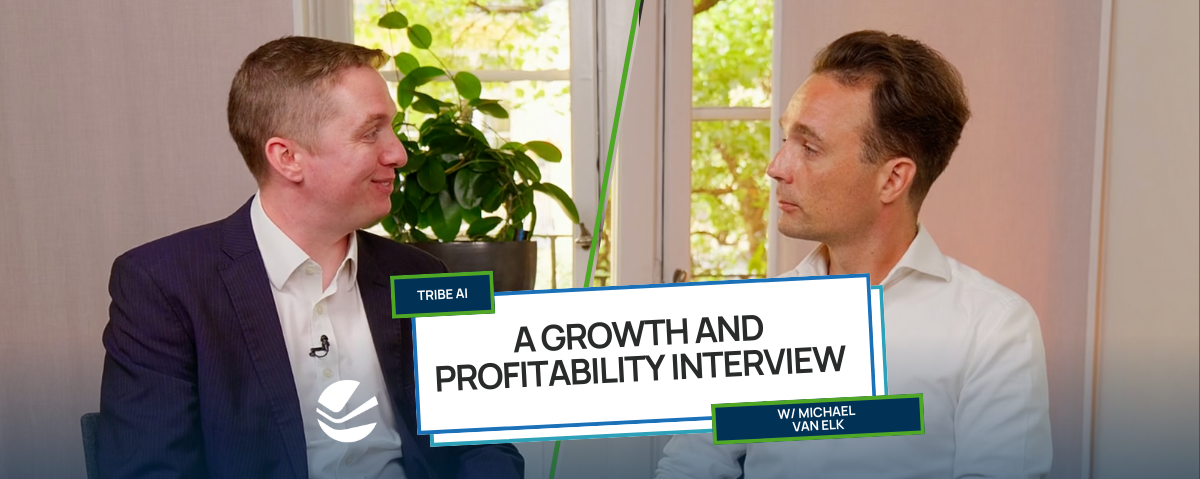
In this interview from Vendavo’s Growth + Profitability Summit 2024 in Stockholm, Chris Kennedy-Sloane, Business Consultant at Vendavo, talks with Michael van Elk, Head of AI Engineering at Tribe AI, to discuss practical applications for AI and how to find those applications for your organization. Plus, Chris gets Michael’s thoughts on the AI hype cycle, the key challenges companies face when trying to adopt AI, and practical AI applications with clear business impacts.
Chris Kennedy-Sloane: Hi there, I’m Chris Kennedy Sloane, here at GPS Stockholm for Vendavo. I’m one of Vendavo’s Business Consultants, and I’m here with Michael van Elk. Would you like to introduce yourself?
Michael van Elk: Sure. My name is Michael van Elk, and I’m head of AI engineering at Tribe AI.
Kennedy-Sloane: So, Michael, what we’d really like to understand is, what is the market actually saying about AI?
van Elk: So, we see a lot of customers that know that they should be investigating this technology. But the real issue for many is finding the right area of application, because there’s many specific applications where it can really shine. But it’s better to make small experiments and iterate fast to find that application, and this is one of the challenges.
Kennedy-Sloane: So, it’s more of a crawl, walk, run situation rather than a big bang.
van Elk: Yeah, absolutely.
Kennedy-Sloane: So, something that’s often discussed is the concept of the hype cycle. Where would you say we are in terms of AI on that hype cycle?
van Elk: I think that’s an interesting question to answer for AI specifically, simply because it’s a very broad category and I think there’s actually many hype cycles that are overlapping on each other. So, we’ve seen a hype cycle around big data and data science and now gen AI, and I would say that we are probably coming down from the peak of inflated expectations when it comes to many of the generative AI applications that maybe people got too excited about. At the same time, the technology is still progressing, and as that noise is dying down, let’s say, the next wave is already coming. So, I think when it comes to AI in general, I don’t think there’s a particular hype cycle. I think this technology will keep growing and keep delivering value.
Kennedy-Sloane: That’s really interesting, because I think there’s almost perhaps some individual company hype cycles. So, companies will heavily invest in AI, and some of those companies are now in their trial disillusionment and moving away briefly from the technology while it matures. How would you say that AI in particular differs from all of the things we’ve seen happen in the past, like the internet and so on?
van Elk: The software was already something that could be applied to almost any domain. And I think AI is only expanding the frontier of places where we can apply this because it’s allowing software systems to reach further and do things that they weren’t able to do before. They always said software is eating the world, and it seems right now AI is eating software and everything else.
Kennedy-Sloane: So, AI is very exciting. A lot of companies are trying to get involved. What are the key challenges they’re facing when they’re trying to get involved with AI?
van Elk: So, I mentioned one already, which is identifying the right use cases. When you have found the use case, you want to bring this to production, which involves some other challenges – again, depending on the use case – but very often this will involve security considerations, quality assurance, and, of course, the data availability is one as well. Generative AI can help in data cleaning and bringing data sources together.
Kennedy-Sloane: So, the AI can actually help you implement the AI?
van Elk: Yep, absolutely.
Kennedy-Sloane: Fantastic. What are some real practical applications that you’ve seen with genuine business impacts that you think are exciting?
van Elk: The first is for code generation. Code is written in many different industries and many different domains, and this is a clear area where you can apply these generative models to produce value. AWS, with their offering, says that applying it to their own software, they have saved 4,500 developer years in terms of productivity. So that is immense. Second, it’s Google. They are obviously developing their own internal version of this, and they have written reports about how that’s going. And the most recent one said that 50% of all code that is going into the code base that they have, 50% of that was suggestions by the model that were accepted by the developer.
Kennedy-Sloane: Wow.
van Elk: So that is showing you that this is not something for junior developers or like only for people who can’t really code. Companies like Google and AWS who have the best people, they’re using this to accelerate their own software development.
Kennedy-Sloane: I almost wonder if, in those situations with those kinds of companies, they get better adoption and acceptance because their programmers understand how to use it correctly.
van Elk: Absolutely. Another application that’s more common is the use in chatbots. And now, with the large language models, the quality of the conversations it can have and the extent to which it can help a customer in customer service has been increasing by leaps and bounds. And because of that, there’s now cases out there. I believe Klarna is one of them that recently put out a press release saying that they reduced resolution time from 11 minutes to two minutes while customer satisfaction remained the same. And so, you can imagine the amount of operational efficiency that you can get with this. It’s immense. So, these are, I think, good areas to look at that might be applicable to many industries – code generation, customer service.
Kennedy-Sloane: Fantastic. Thank you so much, Michael.
van Elk: My pleasure. Real pleasure to be here.
